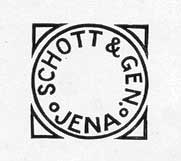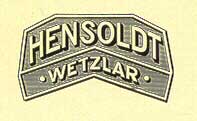Overview
descriptions of the different Zeiss Companies
Carl Zeiss Jena
 The
firm of Carl Zeiss was founded in Jena in 1846 and grew to be the most dominant
optical and fine mechanical firm in the world at the beginning of the twentieth
century through 1945. It was then effectively separated into two firms because
of the partitioning of Germany after World War II. The resulting firms became
Carl Zeiss in Oberkochen (West Germany) and VEB Carl Zeiss Jena (East Germany).
The
firm of Carl Zeiss was founded in Jena in 1846 and grew to be the most dominant
optical and fine mechanical firm in the world at the beginning of the twentieth
century through 1945. It was then effectively separated into two firms because
of the partitioning of Germany after World War II. The resulting firms became
Carl Zeiss in Oberkochen (West Germany) and VEB Carl Zeiss Jena (East Germany).
Collectibles:
Microscopes, Scientific Instruments, Cameras, Photographic Lenses, Astronomical
Instruments, Optical and Medical Devices
Carl Zeiss (Oberkochen)
 In
1945, the upper echelon of the Carl Zeiss Jena scientists and their most senior
management were taken from Jena by the US Army to the small town of Heidenheim
in what would be West Germany. After a year of having no manufacturing resources
and their managers sent to England for denazification, the company began to
reform itself in the non-Russian zones of occupation from scratch. They applied
their knowledge to totally new products since they had no established product
line. These resultant products were years ahead of the industry. They reestablished
the old products of microscopes, binoculars, planetariums among others and became
profitable by 1954.
In
1945, the upper echelon of the Carl Zeiss Jena scientists and their most senior
management were taken from Jena by the US Army to the small town of Heidenheim
in what would be West Germany. After a year of having no manufacturing resources
and their managers sent to England for denazification, the company began to
reform itself in the non-Russian zones of occupation from scratch. They applied
their knowledge to totally new products since they had no established product
line. These resultant products were years ahead of the industry. They reestablished
the old products of microscopes, binoculars, planetariums among others and became
profitable by 1954.
Collectibles:
Microscopes, Scientific Instruments, Cameras, Photographic Lenses, Astronomical
Instruments, Optical and Medical Devices
VEB Carl Zeiss Jena
 The
remnants of the prewar firm were decimated by the loss of senior staff and management
to West Germany. The total assets of the firm were dismantled and sent to the
USSR and restarted itself in Jena based on the products designed before the
war. They had to supply Russia with senior technical staff to start the new
Russian industries based on their former lines of business.. While most of these
advisors were gone for 4-5 years or more, the firm was restarted from scratch
as well in 1947/8. VEB stands for "Peoples Owned Enterprise." After
the collapse of the Soviet bloc, the firm lost their customer base as was dissolved
or portions sold off to successful Western firms.
The
remnants of the prewar firm were decimated by the loss of senior staff and management
to West Germany. The total assets of the firm were dismantled and sent to the
USSR and restarted itself in Jena based on the products designed before the
war. They had to supply Russia with senior technical staff to start the new
Russian industries based on their former lines of business.. While most of these
advisors were gone for 4-5 years or more, the firm was restarted from scratch
as well in 1947/8. VEB stands for "Peoples Owned Enterprise." After
the collapse of the Soviet bloc, the firm lost their customer base as was dissolved
or portions sold off to successful Western firms.
Collectibles:
Microscopes, Scientific Instruments, Cameras, Photographic Lenses, Astronomical
Instruments, Optical and Medical Devices
Schott & Genossen(Schott
and Associates)
 Otto
Schott brought his unique glass experiments to Jena and formed a partnership
with Carl Zeiss and Ernst Abbe which resulted in totally new forms of optical
and other glass. The optical glass enabled Zeiss to manufacture new microscope
objectives and other new breakthrough products as well and helped to assure
their leading scientific prowess for many years to come. The firm became the
leading glass and optical glass firm in the world. Schott, too, was separated
into East and West factions and both prospered until the unification of Germany
when the Eastern firm was merged into the Western firm.
Otto
Schott brought his unique glass experiments to Jena and formed a partnership
with Carl Zeiss and Ernst Abbe which resulted in totally new forms of optical
and other glass. The optical glass enabled Zeiss to manufacture new microscope
objectives and other new breakthrough products as well and helped to assure
their leading scientific prowess for many years to come. The firm became the
leading glass and optical glass firm in the world. Schott, too, was separated
into East and West factions and both prospered until the unification of Germany
when the Eastern firm was merged into the Western firm.
Collectibles:
Bauhaus and other
art glass, Glass Catalogs
Zeiss Ikon AG
 In
1926, many of the leading photographic firms in Germany were in desperate financial
condition. Carl Zeiss Jena joined the major firms of Ica, Contessa Nettel, Ernemann
and Goerz into the firm of Zeiss Ikon. It quickly combined and restructured
the product lines of those firms and developed some of the most revolutionary
photographic products to become the most successful subsidiary of Carl Zeiss
by the mid 1930s. Like Carl Zeiss, it was split into separate firms in 1945.
Both firms were able to recreate themselves with excellent products but for
political and market reasons were out of the business. Zeiss Ikon West was dissolved
in 1970 due to manufacturing costs in Germany and Zeiss Ikon East underwent
numerous name changes and mergers until its identity was lost.
In
1926, many of the leading photographic firms in Germany were in desperate financial
condition. Carl Zeiss Jena joined the major firms of Ica, Contessa Nettel, Ernemann
and Goerz into the firm of Zeiss Ikon. It quickly combined and restructured
the product lines of those firms and developed some of the most revolutionary
photographic products to become the most successful subsidiary of Carl Zeiss
by the mid 1930s. Like Carl Zeiss, it was split into separate firms in 1945.
Both firms were able to recreate themselves with excellent products but for
political and market reasons were out of the business. Zeiss Ikon West was dissolved
in 1970 due to manufacturing costs in Germany and Zeiss Ikon East underwent
numerous name changes and mergers until its identity was lost.
Collectibles:
Cameras, Photographic Equipment, Sophisticated Lock and Key Security Systems,
Adding Machines, Some Medical and Military Devices
Hensoldt AG
 The
family firm of Moritz Hensoldt was gradually purchased by Carl Zeiss from the
late 1920s until it completed owned the firm in 1964. It produced impressive
telescopes, binoculars and microscopes until 1964 when Zeiss relocated its binocular
products into Hensoldt under the Zeiss trademark. Hensoldt's trademark became
used exclusively for military products. The firm was located in Wetzlar.
The
family firm of Moritz Hensoldt was gradually purchased by Carl Zeiss from the
late 1920s until it completed owned the firm in 1964. It produced impressive
telescopes, binoculars and microscopes until 1964 when Zeiss relocated its binocular
products into Hensoldt under the Zeiss trademark. Hensoldt's trademark became
used exclusively for military products. The firm was located in Wetzlar.
Collectibles:
Microscopes, Scientific Instruments, Photographic Lenses, Astronomical Instruments,
Optical and Medical Devices
Winkel (Rudolph
Winkel or Winkel Zeiss or Zeiss Winkel)
 Rudolph
Winkel was a contemporary of Carl Zeiss in the field of microscopes but gradually
the family participation in the business declined and it was sold to Carl Zeiss
who kept it as a totally separate business until 1954 when it became the microscope
division of Carl Zeiss (Oberkochen). The firm was located in Göttingen.
Rudolph
Winkel was a contemporary of Carl Zeiss in the field of microscopes but gradually
the family participation in the business declined and it was sold to Carl Zeiss
who kept it as a totally separate business until 1954 when it became the microscope
division of Carl Zeiss (Oberkochen). The firm was located in Göttingen.
Collectibles: Microscopes,
Scientific Instruments,
Many other
firms were associated with the Zeiss firm and either produced Zeiss products
under license or as partners. Among these were Bausch & Lomb in the USA,
Ross in England, Krauss in France and Koristka in Italy. Small manufacturing
offices were also opened at Gyor in Hungary, St. Petersburg in Russia, Vienna
in Austria and in London, England. Definitive articles on this have appeared
in our Journal.
Our site is comprised of
the following pages. Click on the name of each area to go to that page:
1.
An overview of historical Zeiss Companies and a list of their collectibles
2.
Our Zeiss Historica Publications
3.
A sample article - The Contax camera's migration to Kiev, Ukraine
4.
A second sample article - An unusual Contax I
5.
An index to all of our published articles
6. Links
to other interesting web sites related to Zeiss and photography
7.
Membership Information
8.
Famous Zeiss Designers and Personalities
 The
firm of Carl Zeiss was founded in Jena in 1846 and grew to be the most dominant
optical and fine mechanical firm in the world at the beginning of the twentieth
century through 1945. It was then effectively separated into two firms because
of the partitioning of Germany after World War II. The resulting firms became
Carl Zeiss in Oberkochen (West Germany) and VEB Carl Zeiss Jena (East Germany).
The
firm of Carl Zeiss was founded in Jena in 1846 and grew to be the most dominant
optical and fine mechanical firm in the world at the beginning of the twentieth
century through 1945. It was then effectively separated into two firms because
of the partitioning of Germany after World War II. The resulting firms became
Carl Zeiss in Oberkochen (West Germany) and VEB Carl Zeiss Jena (East Germany). In
1945, the upper echelon of the Carl Zeiss Jena scientists and their most senior
management were taken from Jena by the US Army to the small town of Heidenheim
in what would be West Germany. After a year of having no manufacturing resources
and their managers sent to England for denazification, the company began to
reform itself in the non-Russian zones of occupation from scratch. They applied
their knowledge to totally new products since they had no established product
line. These resultant products were years ahead of the industry. They reestablished
the old products of microscopes, binoculars, planetariums among others and became
profitable by 1954.
In
1945, the upper echelon of the Carl Zeiss Jena scientists and their most senior
management were taken from Jena by the US Army to the small town of Heidenheim
in what would be West Germany. After a year of having no manufacturing resources
and their managers sent to England for denazification, the company began to
reform itself in the non-Russian zones of occupation from scratch. They applied
their knowledge to totally new products since they had no established product
line. These resultant products were years ahead of the industry. They reestablished
the old products of microscopes, binoculars, planetariums among others and became
profitable by 1954. Otto
Schott brought his unique glass experiments to Jena and formed a partnership
with Carl Zeiss and Ernst Abbe which resulted in totally new forms of optical
and other glass. The optical glass enabled Zeiss to manufacture new microscope
objectives and other new breakthrough products as well and helped to assure
their leading scientific prowess for many years to come. The firm became the
leading glass and optical glass firm in the world. Schott, too, was separated
into East and West factions and both prospered until the unification of Germany
when the Eastern firm was merged into the Western firm.
Otto
Schott brought his unique glass experiments to Jena and formed a partnership
with Carl Zeiss and Ernst Abbe which resulted in totally new forms of optical
and other glass. The optical glass enabled Zeiss to manufacture new microscope
objectives and other new breakthrough products as well and helped to assure
their leading scientific prowess for many years to come. The firm became the
leading glass and optical glass firm in the world. Schott, too, was separated
into East and West factions and both prospered until the unification of Germany
when the Eastern firm was merged into the Western firm. In
1926, many of the leading photographic firms in Germany were in desperate financial
condition. Carl Zeiss Jena joined the major firms of Ica, Contessa Nettel, Ernemann
and Goerz into the firm of Zeiss Ikon. It quickly combined and restructured
the product lines of those firms and developed some of the most revolutionary
photographic products to become the most successful subsidiary of Carl Zeiss
by the mid 1930s. Like Carl Zeiss, it was split into separate firms in 1945.
Both firms were able to recreate themselves with excellent products but for
political and market reasons were out of the business. Zeiss Ikon West was dissolved
in 1970 due to manufacturing costs in Germany and Zeiss Ikon East underwent
numerous name changes and mergers until its identity was lost.
In
1926, many of the leading photographic firms in Germany were in desperate financial
condition. Carl Zeiss Jena joined the major firms of Ica, Contessa Nettel, Ernemann
and Goerz into the firm of Zeiss Ikon. It quickly combined and restructured
the product lines of those firms and developed some of the most revolutionary
photographic products to become the most successful subsidiary of Carl Zeiss
by the mid 1930s. Like Carl Zeiss, it was split into separate firms in 1945.
Both firms were able to recreate themselves with excellent products but for
political and market reasons were out of the business. Zeiss Ikon West was dissolved
in 1970 due to manufacturing costs in Germany and Zeiss Ikon East underwent
numerous name changes and mergers until its identity was lost.  The
family firm of Moritz Hensoldt was gradually purchased by Carl Zeiss from the
late 1920s until it completed owned the firm in 1964. It produced impressive
telescopes, binoculars and microscopes until 1964 when Zeiss relocated its binocular
products into Hensoldt under the Zeiss trademark. Hensoldt's trademark became
used exclusively for military products. The firm was located in Wetzlar.
The
family firm of Moritz Hensoldt was gradually purchased by Carl Zeiss from the
late 1920s until it completed owned the firm in 1964. It produced impressive
telescopes, binoculars and microscopes until 1964 when Zeiss relocated its binocular
products into Hensoldt under the Zeiss trademark. Hensoldt's trademark became
used exclusively for military products. The firm was located in Wetzlar. Rudolph
Winkel was a contemporary of Carl Zeiss in the field of microscopes but gradually
the family participation in the business declined and it was sold to Carl Zeiss
who kept it as a totally separate business until 1954 when it became the microscope
division of Carl Zeiss (Oberkochen). The firm was located in Göttingen.
Rudolph
Winkel was a contemporary of Carl Zeiss in the field of microscopes but gradually
the family participation in the business declined and it was sold to Carl Zeiss
who kept it as a totally separate business until 1954 when it became the microscope
division of Carl Zeiss (Oberkochen). The firm was located in Göttingen.